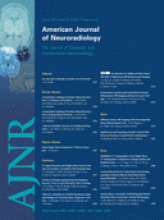Abstract
SUMMARY: Arterial spin-labeling (ASL) is a powerful perfusion imaging technique capable of quickly demonstrating both hypo- and hyperperfusion on a global or localized scale in a wide range of disease states. Knowledge of pathophysiologic changes in blood flow and common artifacts inherent to the sequence allows accurate interpretation of ASL when performed as part of a routine clinical imaging protocol. Patterns of hypoperfusion encountered during routine application of ASL perfusion imaging in a large clinical population have not been described. The objective of this review article is to illustrate our experience with a heterogeneous collection of ASL perfusion cases and describe patterns of hypoperfusion. During a period of 1 year, more than 3000 pulsed ASL procedures were performed as a component of routine clinical brain MR imaging evaluation at both 1.5 and 3T. These images were reviewed with respect to image quality and patterns of hypoperfusion in various normal and disease states.
- Copyright © American Society of Neuroradiology












